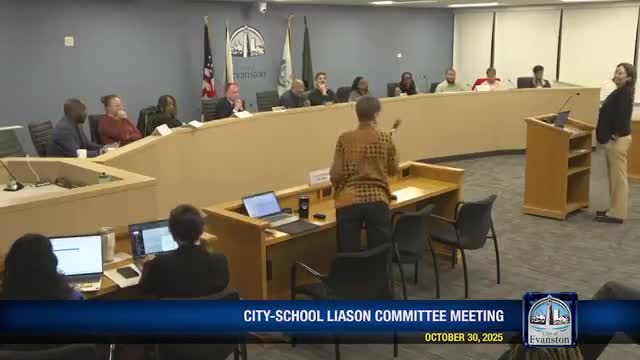District 65 demography reports show multi-year enrollment decline and then stabilization; city and district say forecasts closely align
October 31, 2025 | Evanston, Cook County, Illinois
This article was created by AI summarizing key points discussed. AI makes mistakes, so for full details and context, please refer to the video of the full meeting. Please report any errors so we can fix them. Report an error »

District 65 officials told the City School Liaison Committee Oct. 30 that two recent demography studies — an initial report in 2021 and a McKibben report completed in 2024 — show parallel trends: falling enrollment in the near term and then a flattening of that decline with a modest uptick near the end of the forecast window.
Dr. Beardsley, presenting the district's analysis, summarized the findings: the district's demographers project a net decline of about 7.3% (roughly 401 students) through about 2030, followed by stabilization and a late uptick in the final forecast year. The studies cite an increase in median age and a birth rate below replacement as primary drivers.
District 65 stressed the distinction between population and enrolled students: while city population projections have remained relatively steady, the number of school-age children available to enroll has declined. The district's appendix table shows that the cohort of students who would be high-school age in recent years numbered roughly 987, while the current kindergarten cohort in the same table was listed at about 710.
Evanston/Skokie and ETHS context: ETHS and District 202 officials said their enrollment trends differ; ETHS reported that its recent freshman classes were unusually large and that the high school is not currently threatened by the same decline trajectory. Kendra Williams, ETHS chief financial officer, said ETHS uses District 65 data as an input to projections but adjusts weights because some students who left the district historically later return for high school.
Why it matters: The district said building utilization in District 65 averages about 60%, and that long-term facility planning requires reconciling demographic projections with policy goals such as Envision 2045 and potential zoning changes. District staff cautioned that any zoning-based population growth would take years to affect school enrollment.
What officials asked for next: Board and city members suggested third-party review or collaboration (including potential Northwestern assistance) to reconcile city and district forecasts. District staff and city planners agreed to continue data sharing and to consider forming a joint technical review to align assumptions and time horizons.
Ending: District staff said the district would provide the referenced appendices and recommended data tables to liaison members and available public repositories for further review.
Dr. Beardsley, presenting the district's analysis, summarized the findings: the district's demographers project a net decline of about 7.3% (roughly 401 students) through about 2030, followed by stabilization and a late uptick in the final forecast year. The studies cite an increase in median age and a birth rate below replacement as primary drivers.
District 65 stressed the distinction between population and enrolled students: while city population projections have remained relatively steady, the number of school-age children available to enroll has declined. The district's appendix table shows that the cohort of students who would be high-school age in recent years numbered roughly 987, while the current kindergarten cohort in the same table was listed at about 710.
Evanston/Skokie and ETHS context: ETHS and District 202 officials said their enrollment trends differ; ETHS reported that its recent freshman classes were unusually large and that the high school is not currently threatened by the same decline trajectory. Kendra Williams, ETHS chief financial officer, said ETHS uses District 65 data as an input to projections but adjusts weights because some students who left the district historically later return for high school.
Why it matters: The district said building utilization in District 65 averages about 60%, and that long-term facility planning requires reconciling demographic projections with policy goals such as Envision 2045 and potential zoning changes. District staff cautioned that any zoning-based population growth would take years to affect school enrollment.
What officials asked for next: Board and city members suggested third-party review or collaboration (including potential Northwestern assistance) to reconcile city and district forecasts. District staff and city planners agreed to continue data sharing and to consider forming a joint technical review to align assumptions and time horizons.
Ending: District staff said the district would provide the referenced appendices and recommended data tables to liaison members and available public repositories for further review.
View the Full Meeting & All Its Details
This article offers just a summary. Unlock complete video, transcripts, and insights as a Founder Member.
✓
Watch full, unedited meeting videos
✓
Search every word spoken in unlimited transcripts
✓
AI summaries & real-time alerts (all government levels)
✓
Permanent access to expanding government content
30-day money-back guarantee

